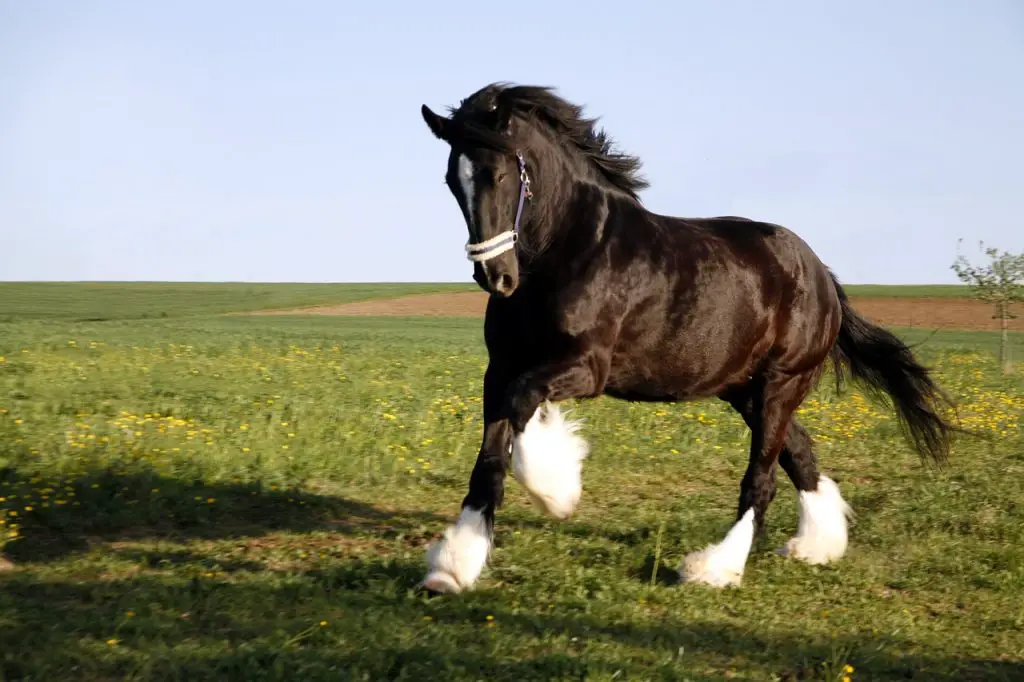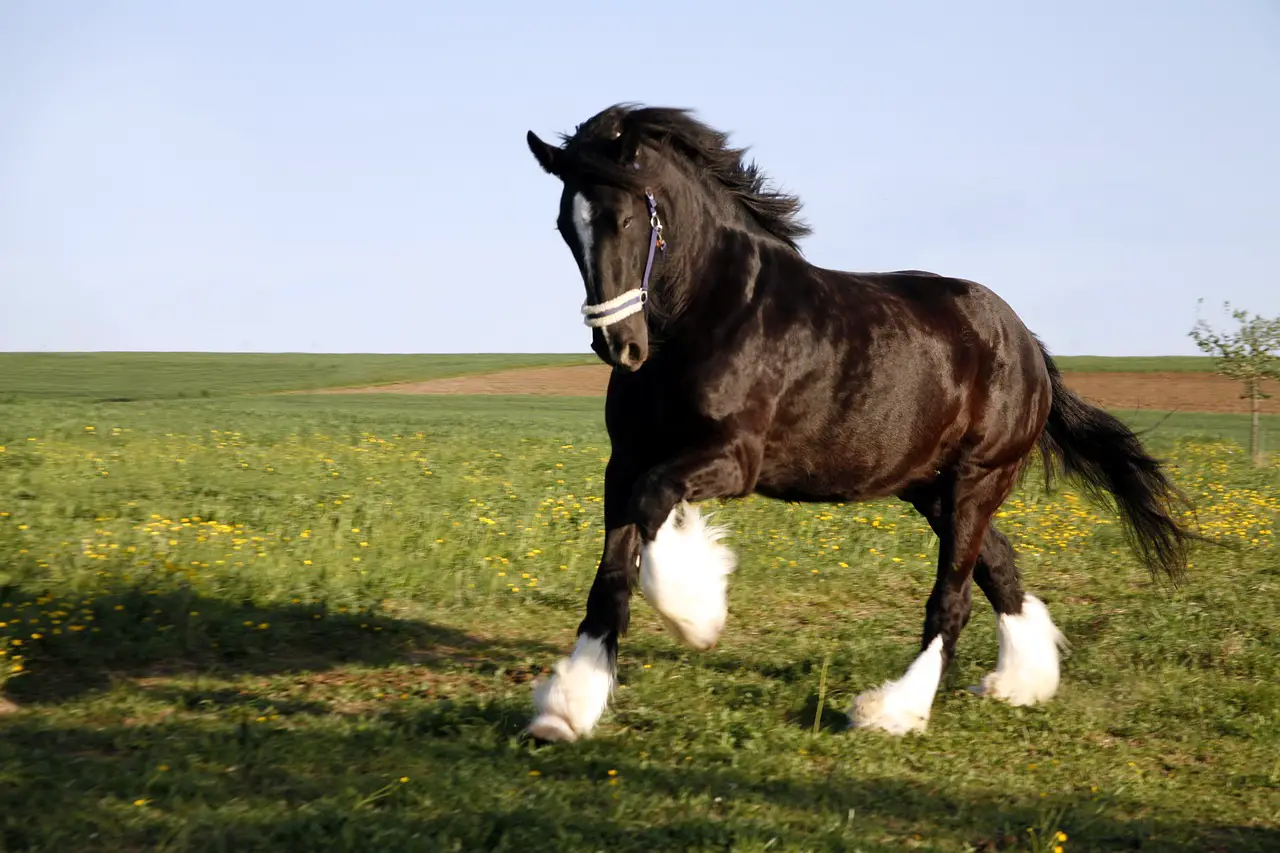Last Updated on March 1, 2022 by Allison Price
The English Shire Horse, among all breeds of draft horses, is the most magnificent. It has a rich and varied history that has seen it adapt to changing times and remain relevant.
This horse is perhaps less well-known than other horses. We’ll be sharing all the details in this post.
Table of Contents [ hide]
- Character and appearance
- Early history – warlike origins
- The modern Shire: A powerful workhorse
- The birth of the railway and the reinventions of the Shire Horse
- The end of the Shire: Mechanization and Decline?
- Revival and reinvention
- The Shire Horse of the US
- Modern uses
- Caring For a Shire Horse
- Health issues
- Is the Shire right breed?
- A beautiful, intelligent animal who has always found his place
Appearance and Character
The Shire’s most distinctive feature is its size. It is one of the largest breeds of horse. It is believed that Mammoth, a Shire, was the largest horse to ever live. He was born in 1846, and measured 21.2 hands (or 218cm or 86in at the withers) when fully grown.
Volume 0%
They are gentle giants despite their size. They are calm and docile, and they don’t get upset easily. They are willing to help and eager to please.
To be registered in Britain as a Shire, stallions have to be either black, bay, or gray. Although chestnut is prohibited in Britain, it is allowed in the USA. Mares and geldings can be black, bay or brown, gray, or roan.
White legs are common, with some patterning occurring on the legs. However, excessive white marks on the face or body are not recommended.
A Shire stallion’s average height is 17.2 hands (178cm and 70in). However, the registry minimum height is 173cm (173cm, 668in). The minimum height for geldings is 16.2 hands (168cm 66in), and it is 16 hands (163cm 64in) for mares.
The long, straight, and slender head of Shires is a hallmark. Although they are often characterized by straight, silky hair, excessive feathering is not desirable.
The shire is a beautiful, elegant horse. It’s no surprise that they are a part of England’s rural cultural heritage. Let’s now look at the story of this noble horse’s origins.
Early History – Warlike Origins
Although the exact origins of Shire are unknown, it is possible that they descend from the English Great Horse, which was bred for war.
When knights began wearing heavy armor in Medieval times, smaller horses and ponies were no longer able bear the weight of the mounted warrior. Therefore, larger horses and ponies were bred.
These horses were replaced by smaller, more agile cavalry mounts as the technology of warfare advanced and knights in armour became obsolete.
These large horses were not obsolete, however, and were used more often for draft work than they were in combat.
The Modern Shire: A powerful workhorse
The 16 th was the next significant development in the history of the Shire Horse. This was when Dutch engineers were sent to England to assist with draining the Fens.
The Dutch engineers brought their Friesian horses with them. They were bred with English horses and were a significant step towards the modern Shire.
These large English horses developed further through selective breeding after the introduction of Dutch blood. The term “Shire Horse” was first used in the middle of the 17 th century. Within another century, it looked the same as it does today.
Large and powerful horses started to replace oxen in the fields around this time due to their intelligence and speed. The Shire’s progenitors were ideal for such work.
The invention of harnesses that allow horses to pull at their maximum strength was a major breakthrough. The harnesses that were used with oxen to prevent horses from breathing properly had been in use for a long time. Oxen have always performed better on heavy farm work.

These powerful horses were also used as cart horses in the beginning. Because roads were uneven and rough in those days, large horses were required to pull carts filled with goods across the country. The Shire was the perfect horse for this task.
As the quality of roads in England improved, smaller horses became more popular for this type of task. Shires were therefore out of favor.
At the same time, however, the country was undergoing the Industrial Revolution and a new network was being constructed. Thus, the Shires found new jobs pulling the barges that carried the large quantities of goods now being made.
The Advent Of The Railway and The Reinvention Of The Shire Horse
The railway was the next chapter of the history of the Shire Horse. The railway network in England grew and the once-essential canals became less important. As a result, the Shires no longer served as barge horses.
However, this didn’t mean that they weren’t needed for transport. These horses, who are reliable and can be trusted to transport the goods from railway stations to their destination, were still required to move the goods.
Shire horses were used to transport many items in the countryside and also for moving items from railway stations to urban areas.
Another job they did was to pull brewer’s carts. These were loaded with beer from breweries to public bars.
Breweries in England used approximately 3,000 horses to accomplish this task in 1893. Many of these would have been the reliable Shire.
They were also needed for essential tasks like garbage collection and coal transportation.
The End Of The Shire: Mechanization and Decline
The versatile Shire Horse has been a constant in the history of the breed. Even when it wasn’t needed for one purpose, another was always possible, ensuring the breed’s survival.
The decline in demand for Shire horses was only possible because of the advent of mechanized farming, and road transport that began in the early 20 century.
Although the invention of the train may have been the beginning, it was the arrival of the tractor that ended the Shire horse’s existence as a regular feature of English life. The numbers started to decline.
The Second World War brought about a dramatic drop in the number of large animals due to the high cost of fodder.
Only a handful of thousand Shire Horses remained in England by the 1950s from an estimated one million.
Revival And Reinvention
The Shire Horse survived, however. Clydesdale blood was introduced in the 1950s to the line. This changed the appearance of the feathering at the legs. A few dedicated breeders tried to revive the breed from the 1970s.
Although Shire horses are no longer needed for transportation or farming, their numbers have increased somewhat. However, various US and UK agencies still consider the breed “at risk”, vulnerable, or critical.
The Shire Horse in the US
The Shire Horse is often associated with England but it was exported to the USA in 1853.
The breed was imported extensively in the years that followed, especially the 1880s. In 1885, the American Shire Horse Association was established.
In North America, Shires were not widely used for agriculture, unlike in England. They were instead used to breed local farmers stock.
But, just as in the UK, draft horses were no longer used. Today, Shires are an endangered breed in the US.
Modern Uses
Modern machines can perform almost all tasks faster and more efficiently than the Shire horses that were once needed.
Some are used in small-scale agriculture, on farms that have been able to show former farming practices, or on farms that aim to use more eco-friendly methods.
Most often, you will see them in competitions and pulling carriages. They are frequently seen at agricultural fairs in ploughing matches, which helps to ensure that age-old skills such as horsemanship and ploughing don’t disappear.
The public can also see the horses in action. This allows people to preserve their cultural heritage.
The canals of England no longer transport goods. However, canal boats are used frequently for leisure and transportation. Some canal boats can be powered but others are pulled by Shire Horses.
Similar to the traditional “gypsy caravans”, Shire Horses can sometimes be seen pulling them, but mostly at rural fairs.
As we mentioned, Shire Horses were able to pull brewer’s drips. A few breweries in England still follow this tradition, including Wadworth Brewery (the Hook Norton Brewery), the Samuel Smith Brewery, and others.
Sometimes, Shire horses are used to do forestry work in areas where motorized vehicles could cause severe damage to the environment.
Finally, Shires can still be kept by private individuals for riding and other leisure activities. This allows the breed to continue its survival.
Caring For A Shire Horse
Shire horses are in many ways easy to care for. The main problem is their size.
They need the same food as other horses, but they require more. They also require more water.
If you want to keep a Shire Horse, you need to be aware of the feathering around the legs. Regular brushing and cleaning is necessary to prevent skin irritations and infections.
Because wet feathering can harbour bacteria and fungal growth, it is important to dry the feathering properly after washing.
A Shire can be cared for in the same way as any other horse, except these details.
Last, equipment for a Shire might need to be measured as regular horses are too small. This could increase the cost of owning one.
Health Problems
Chronic progressive lymphedema is a condition that affects Shire Horses. It’s similar to chronic lymphedema. This causes the horses’ legs to swell over time.
Although polysaccharide storage myopathy does not occur in Shire Horses, it is a rare condition. Some vets recommend a diet high in fat to prevent it.
These issues aside, Shire Horses can live up to 28 years if they are well cared for.
Are You a Shire owner?
The Shire, despite their size and related care issues is easy to maintain and suitable for people with less experience in horse ownership.
They are gentle and calm animals, so they can be more patient with inexperienced riders or owners. They are easy to train.
You should think about the additional work and cost of owning a Shire Horse before you make your decision.
Remember that you will need to have something to hold onto if you intend to ride your horse. It’s difficult to mount a horse this tall as a Shire.
A beautiful animal that has always found its place
We have seen that the Shire Horse has existed for many centuries. As a versatile, strong and willing animal, it has always had a home in the changing world.
While Shires no longer serve the majority of the same jobs, they are still needed to fulfill their role in the modern world. This allows us to preserve the wonderful breed of horse and continue to pass it on to future generations.



